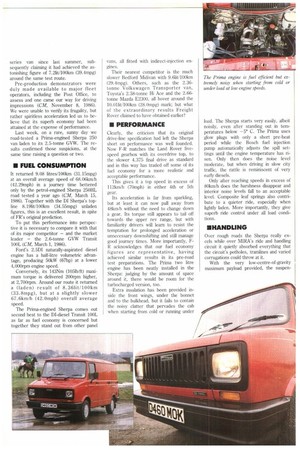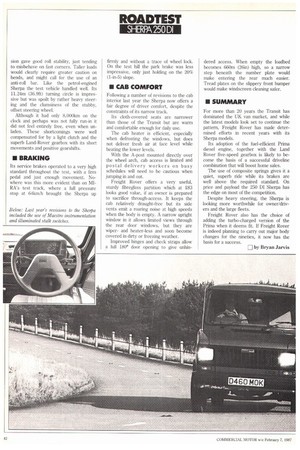INJ ECTING
Page 42

Page 43

Page 44

If you've noticed an error in this article please click here to report it so we can fix it.
IN LIFE By combining the frugal DI Prima engine with a modified driveline Freight Rover aims to give the Sherpa economical running with reasonable performance
• Small direct-injection diesel engines have made impressive debuts in light commercials over the past two years, setting new standards in fuel economy.
First came Ford's naturally-aspirated 2.5DI Transit engine, closely followed by the Iveco Daily's 2.5 litre turbocharged unit. Last October it was the turn of another naturally-aspirated diesel engine — the jointly-developed Perkins/Austin Rover two litre Prima. In a fully-laden Maestro 500 City van (CM, October 4, 1986 it returned 5.68lit/ 100Iun (49.7mpg) around our Kent light van test route which was easily the best fuel consumption in its class.
This must have delighted and encouraged Freight Rover as it had been testing a Prima-powered Sherpa '200' series van since last summer, subsequently claiming it had achieved the astonishing figure of 7.21it/100km (39.4mpg) around the same test route.
Pre-production demonstrators were duly made available to major fleet operators, including the Post Office, to assess and one came our way for driving impressions (CM, November 8, 1986). We were unable to verify its frugality, but rather spiritless acceleration led us to believe that its superb economy had been attained at the expense of performance.
Last week, on a rare, sunny day we road-tested a Prima-engined Sherpa 250 van laden to its 2.5-tonne GVW. The results confirmed those suspicions, at the same time raising a question or two.
• FUEL CONSUMPTION
It returned 9.08 litres/100km (31.15mpg) at an overall average speed of 68.06km/h (42.29mph) in a journey time bettered only by the petrol-engined Sherpa 250HL road tested a year ago (CM, March 15, 1986). Together with the DI Sherpa's topline 8.191it/100km (34.55mpg) unladen figures, this is an excellent result, in spite of FR's original prediction.
To put this performance into perspective it is necessary to compare it with that of its major competitor — and the market leader — the 2.6-tonne GVW Transit 100L (CM, March 1, 1986).
Ford's 2.5D1 naturally-aspirated diesel engine has a half-litre volumetric advantage, producing 50kW (67hp) at a lower 4,000rpm engine speed.
Conversely, its 143Nm (1051b/ft) maximum torque is delivered 200rpm higher, at 2,700rpm. Around our route it returned a (laden) result of 8.3 6lit/100km (33.8mpg), but at a slightly slower 67.6km/h (42.0mph) overall average speed.
The Prima-engined Sherpa comes out second best to the DI-diesel Transit 100L as far as fuel economy is concerned but together they stand out from other panel vans, all fitted with indirect-injection engines.
Their nearest competitor is the much slower Bedford Midivan with 9.61it/100km (29.4mpg). Others, such as the 2.36tonne Volkswagen Transporter van, Toyota's 2.58-tonne Hi Ace and the 2.66tonne Mazda E2300, all hover around the 10.011it/100km (28.0mpg) mark; but what of the extraordinary results Freight Rover claimed to have obtained earlier?
• PERFORMANCE
Clearly, the criticism that its original drive-line specification had left the Sherpa short on performance was well founded. Now F-R matches the Land Rover fivespeed gearbox with its overdrive top, to the slower 4.375 final drive as standard and in this way has traded off some of its fuel economy for a more realistic and acceptable performance.
This gives it a top speed in excess of 112km/h (70mph) in either 4th or 5th gear.
Its acceleration is far from sparkling, but at least it can now pull away from 48km/h without the need to change down a gear. Its torque still appears to tail off towards the upper rev range, but with familiarity drivers will learn to resist the temptation for prolonged acceleration or unnecessary downshifting and still manage good journey times. More importantly, FR acknowledges that our fuel economy figures are representative, having achieved similar results in its pre-road test preparations. The Prima two litre engine has been neatly installed in the Sherpa: judging by the amount of space around it, there would be room for the turbocharged version, too.
Extra insulation has been provided inside the front wings, under the bonnet and to the bulkhead, but it fails to contain the noisy clatter that pervades the cab when starting from cold or running under load. The Sherpa starts very easily, albeit noisily, even after standing out in temperatures below —5° C. The Prima uses glow plugs with only a short pre-heat period while the Bosch fuel injection pump automatically adjusts the spill settings until the engine temperature has risen. Only then does the noise level moderate, but when driving in slow city traffic, the rattle is reminiscent of very early diesels.
Only after reaching speeds in excess of 80km/h does the harshness disappear and interior noise levels fall to an acceptable level. Composite leaf springs also contribute to a quieter ride, especially when lightly laden. More importantly, they give superb ride control under all load conditions.
IIIIIANDLING
Over rough roads the Sherpa really excels while over M1RA's ride and handling circuit it quietly absorbed everything that the circuit's potholes, tramlines and varied corrugations could throw at it.
With the very low-centre-of-gravity maximum payload provided, the suspen sion gave good roll stability, just tending to misbehave on fast corners. Taller loads would clearly require greater caution on bends, and might call for the use of an anti-roll bar. Like the petrol-engined Sherpa the test vehicle handled well. Its 11.24m (36.9ft) turning circle is impressive but was spoilt by rather heavy steering and the clumsiness of the stubby, offset steering wheel.
Although it had only 8,000km on the clock and perhaps was not fully run-in it did not feel entirely free, even when unladen. These shortcomings were well compensated for by a light clutch and the superb Land-Rover gearbox with its short movements and positive gearshifts.
• BRAKING
Its service brakes operated to a very high standard throughout the test, with a firm pedal and just enough movement. Nowhere was this more evident than on MIRA's test track, where a full pressure stop at 64km/h brought the Sherpa up firmly and without a trace of wheel lock. On the test hill the park brake was less impressive, only just holding on the 20% (1-in-5) slope.
• CAB COMFORT
Following a number of revisions to the cab interior last year the Sherpa now offers a fair degree of driver comfort, despite the constraints of its narrow track.
Its cloth-covered seats are narrower than those of the Transit but are warm and comfortable enough for daily use.
The cab heater is efficient, especially when defrosting the windows, but does not deliver fresh air at face level while heating the lower levels.
With the A-post mounted directly over the wheel arch, cab access is limited and postal delivery workers on busy schedules will need to be cautious when jumping in and out.
Freight Rover offers a very useful, sturdy fibreglass partition which at £83 looks good value, if an owner is prepared to sacrifice through-access. It keeps the cab relatively draught-free but its side vents emit a roaring noise at high speeds when the body is empty. A narrow upright window in it allows limited views through the rear door windows, but they are wiperand heater-less and soon become covered in dirty or freezing weather.
Improved hinges and check straps allow a full 180° door opening to give unhin. dered access. When empty the loadbed becomes 660m (26in) high, so a narrow step beneath the number plate would make entering the rear much easier. Tread plates on the slippery front bumper would make windscreen cleaning safer.
• SUMMARY
For more than 20 years the Transit has dominated the UK van market, and while the latest models look set to continue the pattern, Freight Rover has made determined efforts in recent years with its Sherpa models.
Its adoption of the fuel-efficient Prima diesel engine, together with the Land Rover five-speed gearbox is likely to become the basis of a successful driveline combination that will boost home sales.
The use of composite springs gives it a quiet, superb ride while its brakes are well above the required standard. On price and payload the 250 DI Sherpa has the edge on most of the competition.
Despite heavy steering, the Sherpa is looking more worthwhile for owner/drivers and the large fleets.
Freight Rover also has the choice of adding the turbo-charged version of the Prima when it deems fit. If Freight Rover is indeed planning to carry out major body changes for the nineties, it now has the basis for a success.
[2 by Bryan Jarvis












































































